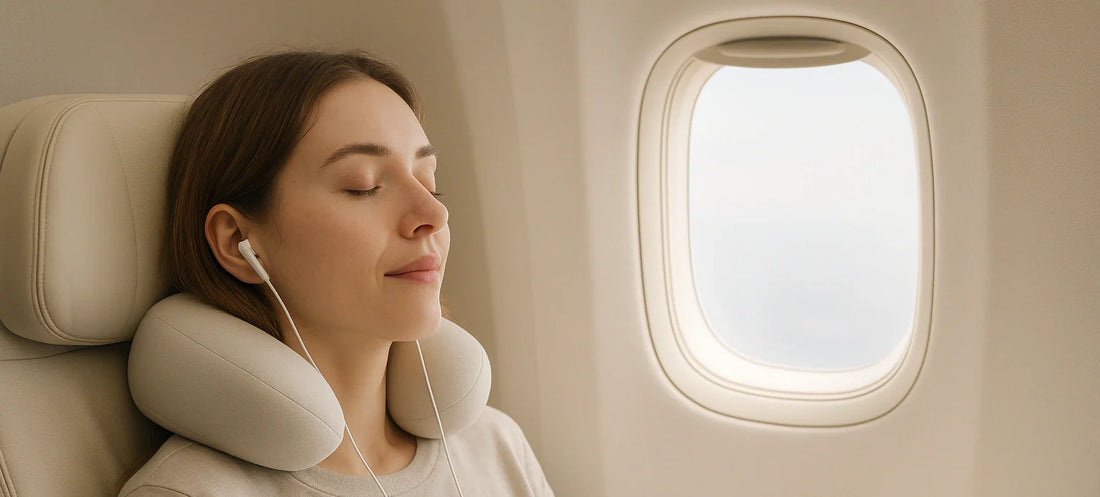
Traveler's ASMR Survival Kit: From 12-hr Flights to Capsule Hotels
Share
Ever wondered why that 12-hour flight to Tokyo feels like an endurance test for your ears? Commercial aircraft generate a steady 85-90 decibels of cabin noise – roughly equivalent to city traffic. Add crying babies, chattering passengers, and the constant hum of air circulation, and you're looking at a sensory assault that can leave you drained before you even reach your destination.
The solution isn't just about blocking noise – it's about creating your personal sanctuary of calm, whether you're crammed into economy seat 32B or settling into a capsule hotel in Shibuya. This comprehensive survival kit transforms any travel scenario into an opportunity for restoration and peace.
Active Noise-Cancelling ASMR Earbuds: The Modern Traveler’s Essential Companion
ANC (Active Noise Cancelling) earbuds effectively block out external disturbances while delivering soothing ASMR sounds. Imagine the gentle patter of rain, the crackle of a campfire, or even soft whispers. These specific sounds don’t just mask noise—they calm the brain through relaxing stimuli, helping you fall asleep more easily. For long-haul flights or crowded train rides, they can be a true game-changer.
Curating Your ASMR Playlist
The secret to a successful ASMR experience lies in personalization. The most effective sounds are those that resonate with you on a deep, calming level. Instead of just hitting "shuffle," take some time before your trip to build a playlist that's your personal travel soundtrack.
- Experiment with sound categories: Do you find the gentle rustle of leaves more soothing than the hum of a distant fan? Explore different ASMR triggers like whispering, tapping, crinkling, or nature sounds (rain on a tent, a babbling brook).
- Layer your soundscape: For maximum effect, consider layering sounds. A track that combines a gentle heartbeat with soft breathing can create a profoundly secure and peaceful feeling.
- Adjust for environment: You may need different sounds for different situations. A soft, consistent sound like a static hiss might work best for blocking out a chatty neighbor, while a more complex nature soundscape might be perfect for unwinding in your hotel room.
- Prioritize simplicity: While there are many complex ASMR tracks, some of the most effective sounds for travel are the simplest. A constant, low-frequency hum or white noise can be incredibly effective at drowning out unexpected noises.
LUFT Cube: Breathing Easy in Confined Spaces
Airplane cabins recirculate air every 2-3 minutes, but that doesn't mean it's clean air. The compact LUFT Cube air purifier (roughly the size of a large smartphone) creates a clean air bubble around your seat using advanced photocatalytic oxidation technology.
Unlike traditional HEPA filters, the LUFT Cube operates silently – no competing white noise to disrupt your carefully curated audio environment. It's particularly valuable during the boarding chaos when cabin doors are sealed but ventilation systems haven't reached full capacity.
For capsule hotels, this device becomes even more critical. These spaces often have minimal ventilation, and the LUFT Cube ensures you're breathing purified air throughout your rest period.
Airline Seat Noise Numbers
Your seat location dramatically impacts noise exposure:
| Aircraft Section | Average Decibel Level | Equivalent Sound |
|---|---|---|
| Front of cabin (rows 1-10) | 78-82 dB | Busy restaurant |
| Wing area (rows 15-25) | 85-90 dB | City traffic |
| Rear cabin (rows 30+) | 82-87 dB | Garbage disposal |
| Near lavatories | 90-95 dB | Lawn mower |
The sweet spot? Aim for seats 6-12 on most aircraft configurations – far enough from engines, close enough to avoid galley and lavatory noise.
Capsule-Specific Challenge
Japanese capsule hotels present unique acoustic challenges. These sleeping pods typically measure 6x3x4 feet, creating an intimate sound environment where every whisper from neighboring pods becomes amplified.
- Volume calibration: Set audio 20% lower than you would at home – the enclosed space amplifies everything
- Breathing room: Run your air purifier on low setting to avoid creating competing white noise
- Frequency selection: Mid-range frequencies (200-2000 Hz) work best in small spaces
- Movement consideration: Choose longer audio tracks (60+ minutes) to avoid mid-sleep interruptions for track changes
